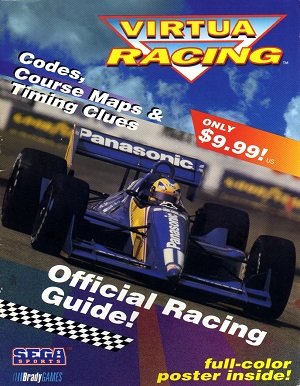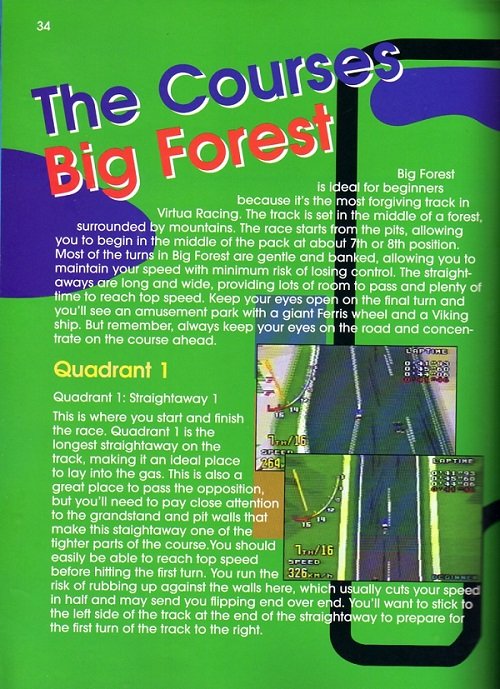
I know what you're thinking, but trust me, you want to read this one.
"Why?"
I know you're questioning. I questioned myself. But as a result of this questioning, I went on my own epic quest of discovery. The story behind this simple seventy-five page guide and what it meant for strategy guides (and Brady Publishing in particular) in the future is nothing short of amazing. Without it, you'd have to re-write the history books on strategy guides. One name in particular would be absent, and the absence of this individual would send shock waves through the space-time continuum.
My fellow retro enthusiasts, gaming historians, and book collectors, I present to you the story of the most significant strategy guide you've never heard of. This, my fine followers, is the story of the Virtua Racing Official Racing Guide, on this extra special installment of "To Guide or Not to Guide."
Note: All images in this article were scanned by me from my own sources.
To Guide or Not to Guide?
Who publishes a strategy guide for an arcade racing title, anyway?
That, I'm sure, was the question on everybody's mind in the mid-90's when this showed up on store shelves. Not because it was plagued by production issues or hampered by low-resolution artwork--neither is the case. Rather it was a case of, "What could this book tell you that the instruction manual couldn't?"
A valid question, all things considered. Virtua Racing was a popular arcade game, to be sure, and its transition home to the Genesis/Mega Drive was a big deal for 16-bit video warriors at the time. But this was hardly Gran Turismo. Players were restricted to a single type of Formula One car with one customization option: automatic or manual transmission. There were a grand total of three tracks. You could race solo against the AI, do a free race around the track in practice mode, or plug in a second controller for two-player head-to-head action.
That was it.
There wasn't any Deathmatch option where you crushed pedestrians. This wasn't about pulling off insane flips or crazy stunts to max out your score. There weren't any licenses to earn, new cars to unlock, bonus tracks to open up (to be fair, you could unlock a 'backwards' mode, where you could drive the three tracks in reverse, but they were still the same tracks, just mirror images of one another), or alien invasions to thwart. Just you, fifteen other cars, and a time limit. So why, exactly, did this game need a strategy guide?
Truth be told, it didn't. That didn't stop Sega from contracting with recent strategy guide arrival Brady to produce one anyway. While the market for such a book wouldn't be huge, Brady was interested in boosting their name recognition and hey: more titles on shelf meant more people seeing "Brady" in conjunction with tip books. Ink now drying on the contract between game developer and book publisher, the question in Brady's office turned to, "Who can we get to write this book?"
If that surprises you, it shouldn't. The rights for guide production (or at least the decision to go 'unofficial' back in the day) were often worked out well before it came time to start banging out words. What shouldn't surprise you is that nobody in Brady's stable of freelance authors wanted to touch it.
Freelancers in the 90's guide business largely worked on a royalty basis, meaning the more copies of a book they sold, the larger their paycheck became. Working on a book for a monster arcade hit like Mortal Kombat or Street Fighter, where the book was an easy way to get move lists and strategies for fighting as or against specific fighters, or the guide for an RPG where the player could be assured reams of monster statistics, item locations, maps, spell listings, and other handy information gave the author a much better chance to earn a sizable hunk of income.
A ten dollar book about driving really fast around a track, even if presented in full color with a removable 18"x24" poster in the back, was the sort of job you'd foist off on an intern, or the guy you want to quit so you can get rid of him without paying him unemployment. Nobody in Brady's work force fit this mold though. They'd only been around for a little over a year, after all, and they were a small company based in Indiana.
While management tried to find some poor unfortunate soul upon which to dump the project (and all of their normal writers presumably pleading unexpected colonoscopies every time the subject came up), the deadline inched closer and closer. Despite this being a book literally no one asked for, Brady couldn't afford to just let this one slide. Mucking up a major contract with Sega would mean losing access to literally half the home gaming market. Management had to make the call, and so, with two weeks to spare, they had to point a finger and drop the hammer.
The target they picked was their in-house "Games Specialist", an idealistic young fellow who came to Brady from a career with Electronics Boutique and Software, Etc., a man who was still looking to find his place in the world of publishing. He learned of his involvement when a co-worker dropped by to let him know, "By the way, they tapped you to write that racing book."
Brady Publishing's Games Specialist was none other than David "I Wrote Practically Every BradyGames Guide You Loved In the 90's" Cassady. I'll let Mr. Cassady pick up the story in his own words from an e-mail interview I conducted with him last month:
I probably went pale. English and I never got along in high school. Reports were one of my least favorite things. To top it off I knew nothing about racing.
Once I stopped panicking, I visited Chris Denny, one of my former managers at Electronics Boutique that now worked at a different imprint in our company, because he was a huge race fan and he was the perfect guy to explain racing to anyone. I begged him to write a few pages on general racing strategy completely unrelated to video gaming. We needed some real racing content even if it didn’t apply to Virtua Racing. He agreed, and I arranged payment for him. Then I dove into the game, slept in my office, and finished the manuscript over the next week and a half. It all came together. Despite my fears we were able to release the guide as planned and before long I would be the first in-house author at Brady Games.
That's right: in a week and a half, Cassady turned out the text for what would become the most-least-important strategy guide ever written, and secured his place as a staff writer for Brady. The contract with Sega was honored, Brady got their shelf space, Virtua Racing got the book it never knew it needed, and Cassady got to write a bunch of much more exciting things. Win-win-win-win all around! :)
Guide
You're damn right I'm marking this a must-own. Owning a copy of the Virtua Racing Official Guide to Racing is the video game equivalent of owning a first-edition copy of Stephen King's "Carrie" or Tom Clancy's "The Hunt for Red October". It's an absolutely silly concept thrust upon an author who initially wanted nothing to do with it, yet it launched the career of one of the most prolific and respected authors of the pre-Internet strategy guide heyday. Cassady went on to pen guides for Final Fantasy VII, Final Fantasy VIII, Final Fantasy XII, SaGa Frontier, Parasite Eve, Final Fantasy Anthology, Jade Cocoon II, Metroid Prime, Metroid Fusion, Turok: Dinosaur Hunter, Metal Gear Solid, Bushido Blade, and numerous other hits.
What's special about this book isn't just Cassady, but the way Chris Denny's basic racing tips are still applicable to racing games today. I'm someone completely clueless about what goes into real-life racing beyond driving fast and turning left, and I'm exactly the target audience for Denny's tips. He explains not only the hows, but also the whys behind everything from the optimal time and way to shift gears to the best ways to take curves. His explanations work for literally every racing game ever made, whether arcade or simulation style. They might be common-sense to people in the know, but I'm not a member of that clique. I've never driven a manual transmission vehicle in real life. I'm totally that target audience.

The rest of the book looks like this: full color, lots of screenshots, and big, easy-to-read text on simple backgrounds. The inside front cover even contains a full list of Game Genie codes, on the off-chance you've read the thing from start to finish and still find yourself sucking. It is the first, last, and only resource for a game you likely haven't thought about for almost twenty-five years.
You'd think this would make it dirt cheap, but 'logic' had nothing to do with the production of this book, so of course it's going to set you back about thirty dollars today. But sometimes the price we pay for our history can be expensive. If you're serious about your collecting though, this is one book you'll want to make sure winds up in your library sooner rather than later. If nothing else, it's a great conversation piece, especially now that you know its history.
Now aren't you glad you kept reading? Glad enough to hit that Upvote button?
I guess we'll find out together, won't we? Thanks, Steemian. Game on! :)
WARNING - The message you received from @amitibikram is a CONFIRMED SCAM!
DO NOT FOLLOW any instruction and DO NOT CLICK on any link in the comment!
For more information about this scam, read this post:
https://steemit.com/steemit/@arcange/phishing-site-reported-steem-link-premium
If you find my work to protect you and the community valuable, please consider to upvote this warning or to vote for my witness.
Downvoting a post can decrease pending rewards and make it less visible. Common reasons:
Submit
Hey @modernzorker, you just received a random 100% upvote for your activity at the @minnowsmith project! Stay tuned and keep mining. :)
Downvoting a post can decrease pending rewards and make it less visible. Common reasons:
Submit
Downvoting a post can decrease pending rewards and make it less visible. Common reasons:
Submit